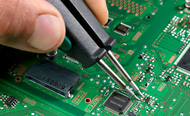Three Product Classes Identified Under J-Std-001 Standard
Posted by Staff - Soldertraining on Jan 27th 2022
The J-STD-001 (Joint Industry Standard) standard that the IPC has issued for soldered electrical and electronic assemblies. It defines materials, processes, and methods to ensure the efficiency and accuracy of the soldering process to produce high-quality solder joints. It will help release a circuit board of optimum quality that adheres to the regulatory standards and customer specifications.
The J-Std training kit lets you build a practical understanding of the soldering process as per real-world requirements. It allows you to work according to the industrial specifications for electronics and electrical assemblies. J-STD-001 is an individual-level certification. It is based on a standard published by IPC titled "Requirements for Soldered Electrical and Electronic Assemblies." The latest version of the J-Std-001 document is J-STD-001 H. The standard was first published in January 1992 as a "parallel document." It was released to complement and later replace the then accepted MIL-STD-2000, High Reliability Soldering Requirements.
Between these standards, J-STD-001 acts as a commercial or industrial "guide-line" for electronics and electrical assemblies, grouped as per the product classes. These "product classes" are based on their end-use environment, and to a certain extent, according to the assembly costs. Previously, the MIL standards only had a single product class to specify requirements to acquire the optimum quality and reliability. The three product classes identified under the J-Std-001 standard are classified according to manufacturability, process control regulations, performance requirements, and verification testing. These include:
Class 1 Electronics: General Electronics Products
It includes circuit boards with the lowest quality requirements and is generally a part of products with simple functions and a short life cycle. Class one electronics cover the day-to-day electronic products found in homes. Examples include LED lights, toys, TV remote control, and others. These products are usually found in cheap, high-volume productions.
Class 2 Electronics: Dedicated Service Electronics Products
The circuit boards under this class have extended life and exhibit higher characteristics than class one. Class two encompasses electronic devices, which require continued performance and an extended life cycle. The product's manufacturing process must adhere to stringent standards to achieve this. In these products, uninterrupted service is desirable but not critical. Examples include smartphones, laptops, communication equipment, among others.
Class 3 Electronics: High-Reliability Electronics Products
The products that belong to this class must provide performance-on-demand or continued high performance. These products must not suffer any downtime, and it is often used in the uncommonly harsh end-use environment. They are subjected to strict guidelines because of their importance in the field. Class three electronics are mission-critical items that must ensure uninterrupted service. Since these require a high level of reliability and dependability, it undergoes robust inspection before release. It includes military devices, support systems, and electronic manufacturing systems.
What topics are covered under J-Std-001 certification?
The J-Std-001 certification covers a comprehensive explanation of the following:
Material, component, and equipment
Surface mounting of components
Through-hole mounting
Soldering and assembly requirements
Terminal and wire connection
Coating, encapsulation, and adhesives
Cleaning and residue requirements
To Conclude:
The J-Std-001 standard thus enables the stakeholders to make high-quality soldered interconnections (leaded and lead-free) and adhere to the assembly requirements of the given product class to make quality releases.

